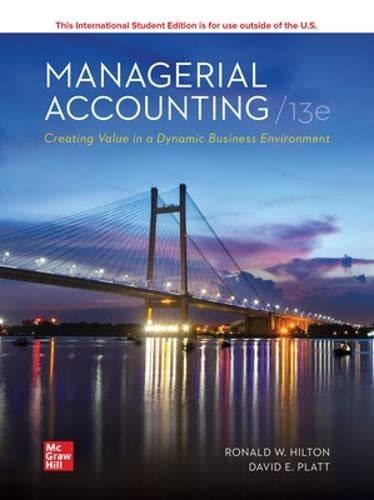Question
General Electric (GE) bases most of its US production out of the GE Appliance Park in Louisville, Kentucky. Building One at Appliance Park (abbreviated as
General Electric (GE) bases most of its US production out of the GE Appliance Park in Louisville, Kentucky. Building One at Appliance Park (abbreviated as AP1) manufactures both washers and dryers. While there are several different models of each, for purposes of this problem, assume that all washers are identical and that all dryers are identical. AP1 uses a standard costing system, in which estimation error is NOT allocated to specific cost objects. AP1 uses a weighted average cost approach over all of its inventory and allocates fixed overhead based on direct labor hours.
As of August 31, AP1 has finished goods inventory consisting of 400 washers and 800 dryers. The value of this inventory, under absorption costing, on AP1s balance sheet as of 8/31 includes $262,000 of fixed overhead costs for the washers and $369,600 of fixed overhead costs for the dryers.
For the month of September, AP1 expects to produce 5,000 washers and 5,000 dryers, using 30,000 direct labor hours for the washers and 25,000 direct labor hours for the dryers. Due to the residual effects of a large fire in April, actual output is only 4,000 washers and 3,000 dryers. Direct labor hours are 29,000 for the washers and 21,000 for the dryers. Total fixed overhead for the plant is expected to be $5,500,000. Actual fixed overhead is $5,700,000.
AP1 sells 4,200 washers and 3,300 dryers during September (all other appliances are in finished goods inventory as of September 30).
For this year, the AP1 dryer manager will have a bonus which is based on the gross margin ratio earned by the plants dryer sales (gross margin is defined as (revenue minus cost of goods sold) divided by revenue). For each of the following cases, what should the plant manager do if the goal is to increase the current years gross margin ratio, irrespective of any other considerations should she increase the number, decrease the number or does it not matter? Briefly explain your answer (1-3 sentences should be sufficient). In both cases, assume the plant uses absorption costing, has no beginning inventory, but expects to have ending inventory. Also, assume that any changes are made to both actual and budgeted numbers (i.e., that the changes are not surprises). Treat each of the cases below independently. (10 points)
CASE A: The plant manager only controls sales volume (she has no control over any other numbers, including actual costs and production volumes).
Increase sales volume Decrease sales volume Doesnt matter
CASE B: The plant manager only controls production volume (she has no control over any other numbers, including actual costs and sales volume).
Increase production volume Decrease production volume Doesnt matter
Step by Step Solution
There are 3 Steps involved in it
Step: 1

Get Instant Access to Expert-Tailored Solutions
See step-by-step solutions with expert insights and AI powered tools for academic success
Step: 2

Step: 3

Ace Your Homework with AI
Get the answers you need in no time with our AI-driven, step-by-step assistance
Get Started


